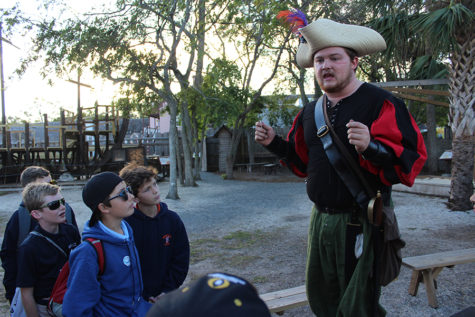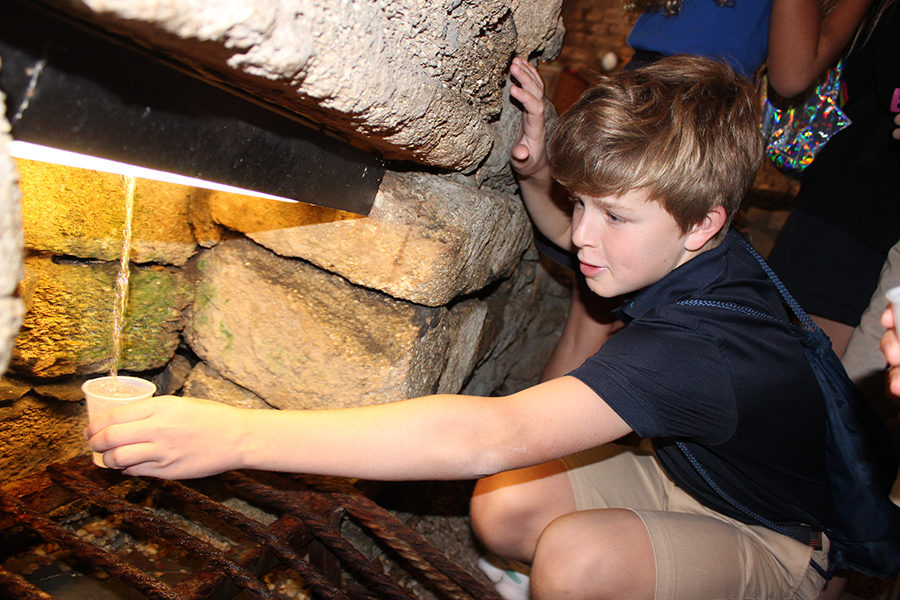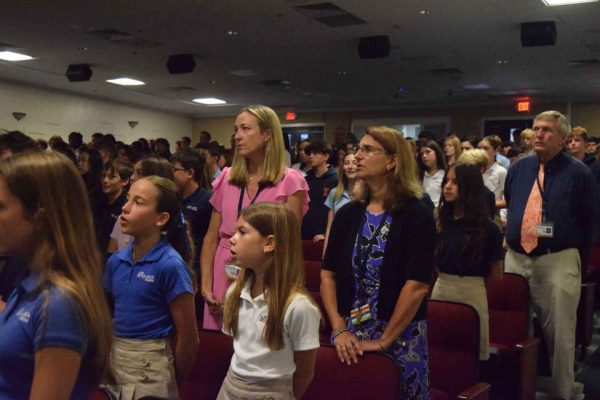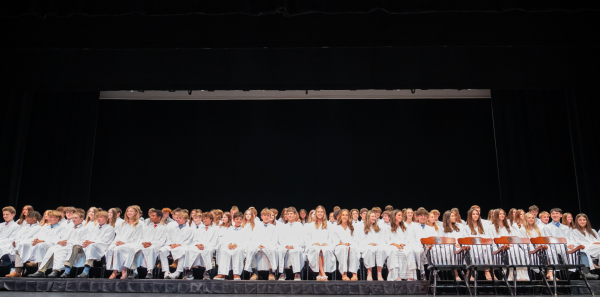Sixth Graders Set Upon St. Augustine
Sixth grader WIlson Stewart collects some drinking water from the Fountain of Youth during the grade’s first stop in St. Augustine.
The oldest settlement in the United States, St. Augustine is filled with historic traditions, sites, and stories, making it the perfect city to visit for students studying pre-Colonial and Colonial America. On Friday, November 17, the sixth-grade students did just that as they took a field trip to St. Augustine to gain some first-hand knowledge of early U.S history.

While visiting the Castillo de San Marcos, sixth grader Grayson Murphy takes a moment to snap a selfie with a gentleman dressed as a 17th century Spanish soldier.
The sixth graders were thrilled at the prospect of traveling to “The Ancient City.” “I’ve never been [to St. Augustine] before,” said sixth grader Emma Nordland. “I’m excited to see the Castillo de San Marcos because we learned about [it], watched videos, and it seems really cool.” Fellow sixth grader Xan Blount concurred with Nordland: “I’ve been [to St. Augustine] once, but I was little, so I don’t remember much. I’m excited to see the [Castillo] because [our class learned about it] through history and videos, but we’ve never actually seen it.”
The sixth graders had to be on campus by 5:30 a.m., not only because the bus left at 6:00, but also because it is a four-hour ride to St. Augustine. Students passed the time by eating some snacks, playing a few games, watching movies, and taking a good nap. “The bus ride was too long, [but] we [had fun by] screaming a lot and watching movies,” said sixth grader J. Paul Jacobs. Sixth grader Chase Malamala said, “[On the bus ride], I played a lot of card games [like UNO] with the person next to me.”
After the bus ride, the students were divided into two groups. Both groups saw the same attractions at different times, but for their first stop, both

One of the tour guides in the Colonial Quarter talk to the students about life in St. Augustine during the 16th and 17th centuries.
groups joined up to see the Fountain of Youth, the mythical fountain that is supposed to make one young again if they drink the water. Juan Ponce de Leon, a Spanish explorer, discovered Florida in 1513 and believed the fountain held magical powers. In reality, according to the www.fountainofyouthflorida.com website, “the spring issues forth directly from the Floridan aquifer, which lies below ground under much of North Florida. The water contains over 30 minerals and the spring would have been the perfect replenishment site for Juan Ponce de Leon’s ships upon landing on Florida’s shores 500 years ago.”
Most students, though, did not find the drink refreshing. “[The water] tasted like chlorine,” said sixth grader Julian Janin. “I had two cups of it and it [did] not taste like water,” said fellow sixth grader J. Paul Jacobs.
The Fountain of Youth Archaeological Park, which houses the spring, also hosts a number of Living History Interpreters who dress like the native Timucuans and Spanish settlers of the day, and provide information about what life was like back then. Students were able to see weapon demonstrations through the Living History Interpreters, including live firings of a crossbow, rifle, and mini cannon.
The students then ate lunch at an outdoor café before taking part in an archaeological dig at the Old Florida Museum. They sifted through sand to find artifacts and ecofacts in a mock dig, then measured, drew, and compared the items they found. The students next went on an informational trolley tour of the city and visited what many of the students had been waiting for: the Castillo de San Marcos.
The Castillo de San Marcos is a powerful fortress that was built by the Spanish in 1695. Construction started in 1672, so it took 23 years to build the fort. It took so long to build because it is so big,

Sixth grader Luca Balzano inspects an actual dried alligator hide in the FOuntain of Youth Archaeological Park.
and it is made of coquina – a type of rock made up of shells which takes many years to dry and become hard. The Spanish built the Castillo de San Marcos out of coquina because it is like styrofoam, so when a cannonball hit it, it absorbed the impact of the cannonball, and did not shatter. This way, the Spanish never had to worry about the Castillo being destroyed when it came under attack, which happened in 1702 and 1740 at the hands of the English.. The fortress was only taken over by treaty in 1763, when it was given to the British. Now, the oldest masonry fort in the continental United States is a national monument.
Many of the students’ favorite part of the visit, however, was what happened on the top level overlooking the Mantanza River. “It was interesting watching the cannon go off,” stated sixth grade Maggie Smith. “It was really loud.” Several gentlemen dressed as 17th-century Spanish soldiers fired the cannon without the cannonball, creating a loud and exciting spectacle for visitors to the Castillo.
After tours of the fortress and the Colonial Quarter Museum, the students had dinner at Barnacle Bills, a restaurant known for its surf and turf. Students had a choice of chicken fingers, grilled chicken sandwiches, fried shrimp and rice, a cheeseburger, or a hamburger. “The food was so good, [and] the Coke [and] Sprite were excellent,” said sixth grader Luca Balzano. “I gained at least two pounds.”
Finally, the sixth graders returned home on the charter bus. “It was a very long bus ride, but we got to see monuments, and we got to go on rides around St. Augustine,” said sixth grader Brynn Weisser. “[I liked] watching the cannons [being fired].”
“St. Augustine was a very fun experience,” added Balzano. “I saw many things I thought I would never see in my life. I saw a cannon go off, and the teachers were very nice to us.”
The excursion was certainly a rewarding one for the students, and helped bring to life the period they are studying in history





